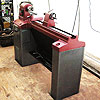I'm building a router table from plans from Wood magazine {Sept 09, issue 192, page 56, Router table and Organizer}.
The plan calls to add poplar strips to the MDF base of the table top then laminate not only the MDF but the poplar strips. I'm concerned about this, can't the poplar strips move over time causing the laminate to buckle?
I'm thinking it's best to to add the trim to the laminated MDF to finish.
Phil




 Reply With Quote
Reply With Quote





